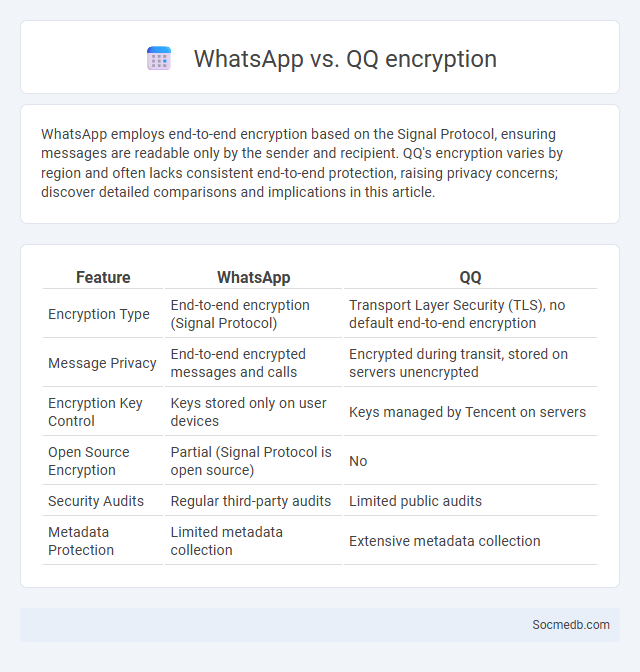
Photo illustration: WhatsApp vs QQ encryption
WhatsApp employs end-to-end encryption based on the Signal Protocol, ensuring messages are readable only by the sender and recipient. QQ's encryption varies by region and often lacks consistent end-to-end protection, raising privacy concerns; discover detailed comparisons and implications in this article.
Table of Comparison
| Feature | ||
|---|---|---|
| Encryption Type | End-to-end encryption (Signal Protocol) | Transport Layer Security (TLS), no default end-to-end encryption |
| Message Privacy | End-to-end encrypted messages and calls | Encrypted during transit, stored on servers unencrypted |
| Encryption Key Control | Keys stored only on user devices | Keys managed by Tencent on servers |
| Open Source Encryption | Partial (Signal Protocol is open source) | No |
| Security Audits | Regular third-party audits | Limited public audits |
| Metadata Protection | Limited metadata collection | Extensive metadata collection |
Understanding Encryption: Basics and Importance
Encryption secures your social media data by converting information into code, preventing unauthorized access and protecting personal communications from hackers. Understanding encryption algorithms like AES and RSA helps you recognize how platforms safeguard shared content and maintain privacy. Your awareness of encryption's role enhances both your online security and trust in digital interactions.
What is End-to-End Encryption?
End-to-end encryption (E2EE) is a security measure that ensures only you and the intended recipient can read the messages exchanged on social media platforms. It encrypts data on your device and decrypts it only on the receiver's device, preventing intermediaries, including service providers, from accessing the content. This technology protects your private conversations from hackers, governments, and unauthorized third parties.
How WhatsApp Implements End-to-End Encryption
WhatsApp employs end-to-end encryption by using the Signal Protocol, ensuring that messages are encrypted on your device and only decrypted on the recipient's device, preventing third parties from accessing the content. Each message is secured with a unique lock and key, making it nearly impossible for hackers, service providers, or government agencies to intercept or read your communications. This encryption covers not only text messages but also voice calls, video calls, photos, and group chats, providing comprehensive privacy protection across the platform.
QQ Messenger: Encryption Methods Explained
QQ Messenger employs advanced encryption methods such as AES-256 and RSA to secure your conversations and data transfers. End-to-end encryption ensures that only you and the intended recipient can access message content, preventing unauthorized interception. This robust security framework safeguards privacy and enhances trust in digital communication.
Comparing Encryption Protocols: WhatsApp vs QQ
WhatsApp employs the Signal Protocol, providing end-to-end encryption that ensures only communicating users can read messages, enhancing user privacy through forward and future secrecy. QQ uses a combination of SSL/TLS for transport encryption but lacks consistent end-to-end encryption, making it more vulnerable to interception and data mining on the server side. Comparatively, WhatsApp's robust encryption framework offers a higher level of security and confidentiality in social media communications than QQ.
Data Privacy: User Protection in WhatsApp and QQ
WhatsApp employs end-to-end encryption to ensure user messages and calls remain private, preventing unauthorized access and enhancing data security. QQ integrates multiple layers of user authentication and data encryption to protect personal information from cyber threats. Your data privacy on these platforms is safeguarded through strict security protocols designed to uphold user trust and confidentiality.
Vulnerabilities and Security Flaws
Social media platforms often face vulnerabilities such as weak authentication protocols, data breaches, and susceptibility to phishing attacks that compromise user accounts and personal information. Exploited security flaws in APIs and third-party integrations can lead to unauthorized data access and privacy violations, putting Your digital identity at risk. Implementing multi-factor authentication and regularly updating privacy settings are crucial steps to mitigate these risks and enhance Your overall social media security.
Government Surveillance and Data Requests
Government surveillance on social media platforms involves monitoring user activity and communications to detect potential threats and enforce laws. Data requests submitted by government agencies compel platforms to share user information, including messages, location data, and account metadata. Transparency reports from companies like Facebook and Twitter reveal increasing trends in such requests, raising concerns about privacy and civil liberties.
User Control Over Privacy Settings
You have extensive control over privacy settings on most social media platforms, allowing you to customize who can view your posts, send messages, and access personal information. Adjusting these settings helps protect your data from unauthorized access and limits exposure to targeted ads or unwanted contacts. Staying informed about platform updates on privacy features ensures your online presence remains secure and aligned with your preferences.
Which Messenger Offers Stronger Encryption?
Signal Messenger provides end-to-end encryption by default for all messages, ensuring your conversations remain private and secure. WhatsApp also uses robust end-to-end encryption based on the Signal Protocol but is owned by Meta, which raises concerns about data privacy and metadata collection. For users prioritizing strong encryption without compromise, Signal is widely regarded as the more secure choice among popular messaging apps.
 socmedb.com
socmedb.com